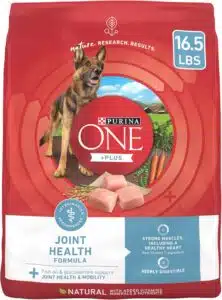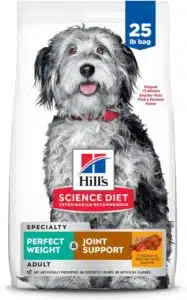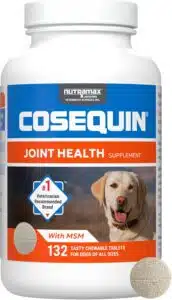Did you know that “dog food for joint health” is essential for keeping your dog mobile and comfortable as they age? Nutrition is crucial when it comes to supporting joint function as dogs get older, or if that reaches them with conditions like arthritis or hip dysplasia.
So, with the added benefit of using “dog food for joint health,” you can help prevent or alleviate these common ailments so your furry friend remains active and pain-free. In this post, we’ll help dog owners choose their optimal food options for joint health, so your furry friend can continue to enjoy a more comfortable more energetic life.
Why Joint Health Matters for Dogs
Good joint health is important for a dog’s overall well-being, but becomes especially important as they age. As dogs get older, they can suffer from more common joint issues like arthritis, joint pain, and decreased mobility.
Such conditions can severely compromise your dog’s quality of life and make it difficult to play, exercise or even walk comfortably. This is where dog food for joint health comes in kindly.
The right dog food for joint pain will save you some major goodbye pain relief in a shake.. Many premium dog foods have formulas specifically designed with ingredients like glucosamine, chondroitin, and omega fatty acids to support joint health.
These nutrients complement one another as they support cartilage health, combat inflammation and aid mobility — all the more important as dogs enter their senior years.
So, best dog food for joints and hips, for example, usually has glucosamine, which helps to build and maintain the structure and flexibility of cartilage in the joints and chondroitin, which helps maintain the cartilage and keeps the joints flexible.
Together, these ingredients contribute to some of the best dog food for hips and joints, preventing wear and tear as the years pass. Also, omega fatty acids, which can be found in dry dog food for joint health, have anti-inflammatory properties that might help reduce joint pain and stiffness.
Meanwhile, although a nutritious diet can be an excellent technique useful for dog joint health, it is most effective when combined with joint supplements.
Joint supportive supplements, including glucosamine chews or MSM, can also be added to your dog’s regimen. Together decent diet and supplementation that form the foundation for parasitic infection prevention.
How the Right Dog Food Supports Joint Health
Choosing the right “dog food for joint health” is crucial in helping to maintain and improve your dog’s joint function over time. Joint issues, such as arthritis and hip dysplasia, can be mitigated by providing dogs with the right nutrients to support healthy cartilage and joint mobility.
When selecting dog food for joints and hips, it’s important to look for key ingredients that promote joint strength and reduce inflammation.
In dog food for hips and joints, glucosamine is one of the most important nutrients. This naturally occurring compound is a building block of cartilage, the tissue that acts as a cushion for the joints. It aids in maintaining the health of cartilage, making it more effective in absorbing shock and regulating joint friction.
More than it can facilitate in avoiding new damage or damage to the joints, gluscosamine can relieve pain in the degenerating cartilages.
And when combined with another ingredient called chondroitin, which helps it to retain water in cartilage, they work together in a complementary way to help joints stay healthy and flexible, making them an important component in the best dog food for joints and hips.
An important thing to add to dog food for joint pain is omega-3 fatty acids, which are commonly found in fish oils. It has anti-inflammatory properties that reduce swelling and pain in the joints.
Omega-3s — specifically EPA and DHA — have been found to help decrease inflammation related to arthritis, helping with mobility and overall joint comfort. That is why joint health dog food contains a good amount of omega-3, and it is sure to treat dogs prone to joint health issues.
Alongside these joint-supporting nutrients is high-quality protein, which the right dog food should have. Animal proteins like chicken, turkey or fish have amino acids that help keep muscles strong.
Strong muscles help support the joints so this is crucial, especially in older dogs or if the dog already has a problem with their joints. Having correct amounts of muscle tone can alleviate the amount of force placed on the joints, and can support better motion and overall movement of the joint. A high-quality protein diet helps to keep your dog strong and avoid further issues with the joints.
Feed your joint health Inflammation contributes to pain and stiffness in the joints, which is why feeding the right “dog food for joint health” is so vital to having healthy dogs. Many companies that offer dog food for joints and hips add turmeric or green-lipped mussel, both of which have anti-inflammatory properties.
These ingredients alleviate joint swelling and, along with glucosamine and omega-3 fatty acids, help to relieve pain and suffering caused by arthritis and other conditions that affect the joints.
To sum it all up, the best dog food for joint health provides a comprehensive solution to protect your dog’s mobility and enable better joint function. (The nutrients glucosamine, chondroitin, omega-3 fatty acids and high-quality protein combine to stimulate cartilage, control inflammatory pathways and promote the preservation of muscle mass.)
Used in conjunction with the right supplements, this specific feed can enhance the quality of life for your dog and reduce the chances of joint health degrading with time.
The Best Dog Food for Joint Health: Top Picks
So when searching for the best dog food for joint health, you need to make sure you choose food that promotes mobility, cartilage health and overall joint function.
Certain brands have special formulas made to reduce inflammation, enhance flexibility and strengthen bones and muscles. Here’s how to review the best dog food and joint health supplements with efficacy to support healthy joints and mobility in your pets.
1. Purina ONE +Plus Joint Health Formula
Key Ingredients:
For dogs that require joint support, this Purina ONE +Plus Joint Health Formula dog food is a great deal. It includes glucosamine and fish oil, both of which are known to promote joint health and reduce inflammation.
This high-protein kibble, which lists real chicken as the first ingredient, is designed to help maintain muscle mass and support strong joints. The omega-6 fatty acids in the formula are also beneficial for a glossy coat and healthy skin.
Pros:
- Contains glucosamiine and fish oil to boost joint health
- Contains natural antioxidants to help immune function
- ZERO ARTIFICIAL PRESERVATIVES, COLORS OR FLAVORS
- Muscle-maximizing, high-protein formula
Cons:
- Certain dogs may be sensitive to the taste
- More calories (slightly more calories)
Formulated holistic benefits from healthy joints to a shiny coat, Purina ONE is a dry dog food for joint health that is an exceptional option for overall canine wellness.
 2. Hill’s Science Diet Perfect Weight & Joint Support
2. Hill’s Science Diet Perfect Weight & Joint Support
Key Ingredients:
Hill’s Science Diet Perfect Weight & Joint Support contains glucosamine and chondroitin, helping support cartilage and improve joint function.
The protein-rich chicken and brown rice helps flesh the muscles and keeps the dog thin, which is of the utmost importance for canines suffering from joint problems.
Pros:
- It helps in having a healthy joint and weight management
- Formulated to enhance joint health and cartilage qualityUsing glucosamine and chondroitin
- Omega-3 fatty acids and inflammation
- Veterinarian recommended
Cons:
- A bit pricier than some other options
- Others dogs may need time to become accustomed to the taste
This is great for adult dogs or dogs whose needs extend to joint support and weight management — especially for those with arthritis or hip dysplasia.
 3. VETIQ Glucosamine Hip & Joint Supplement for Dogs
3. VETIQ Glucosamine Hip & Joint Supplement for Dogs
Key Ingredients:
This choice is not a food product per se, but it is one of the greatest dog joint health supplements any dog food will benefit from: it’s a VETIQ Glucosamine Hip & Joint Supplement.
It has glucosamine, “MSM”, and “fish oil”, all essential for protecting cartilage and reducing joint inflammation. These chicken-flavored soft chews are great for dogs who are experiencing joint pain due to old age or daily exercise.
Pros:
- Helps ease joint stiffness
- Includes glucosamine, MSM and omega-3s for joint health
- Yummy chicken flavor dogs adore
- Promotes healthy connective tissues and muscles
Cons:
- It may not work for all dogs in supplement form
- Some dogs may have digestive upset in the beginning
VETIQ joint health supplement is the best addition to your dog’s regular food, especially if you see any joint pain or stiffness.
 4. Nutramax Laboratories Cosequin Maximum Strength Joint Health Supplement
4. Nutramax Laboratories Cosequin Maximum Strength Joint Health Supplement
Key Ingredients:
Nutramax Laboratories Cosequin contains “glucosamine hydrochloride“, “sodium chondroitin sulfate” and “MSM” which are all important to supporting normal cartilage and joint function. This supplement is available in chewable tablets for consumption by dogs large and small.
Pros:
- Promotes joint function and supports cartilage health
- Chewable tablets that are easy to serve
- Veterinarians highly recommend this
- Made in U.S.A. of domestically sourced ingredients
Cons:
- Must be purchased separately with dog food
- Potential limitations of tablets for your dog
Cosequin Maximum Strength — While keeping to one of the best dog foods for joint pain, this is an excellent supplement to improve joint flexibility and mobility in dogs with arthritis or joint conditions.
When searching dog foods with the formula for “best dog food for joint health“, beneficial ingredients include “glucosamine“, “chondroitin“, and “omega-3 fatty acids“. Great formulations to support your dog’s joint health include “Purina ONE +Plus Joint Health Formula”, “Hill’s Science Diet”, and “VETIQ Glucosamine”
Combining high-quality dog food with a trusted joint supplement, such as Cosequin, can significantly improve your dog’s mobility, reduce inflammation, and ensure a healthier, happier life.
Key Ingredients to Look for in Dog Food for Joint Health
Lumped together in the best dog food for joints and hips conversation, it’s important to specifically look for ingredients that can help your pup maintain proper joint function, alleviate pain and improve mobility.
The appropriate nutrients can be an absolute game changer for handling joint problems for example arthritis or hip dysplasia. Here’s a run-down of the main ingredients that support healthy joints and hips in dogs:
1. Glucosamine & Chondroitin
All of which are two of the most essential ingredients to maintain dog joint health. Glucosamine is a naturally occurring substance in the cartilage where it is responsible for building and repairing cartilage.
It provides shock absorption and friction reduction between joints, relieving discomfort related to joint degradation. Chondroitin works in conjunction with glucosamine by helping cartilage retain water, which keeps it flexible and resilient.
They make up the pillars of the best dog food for joints and hips, providing essential coverage for your dog’s joints (especially if they’re older or have joint pain).
Glucosamine and chondroitin prevent the breakdown of cartilage, and thus reduce the inflammation that can be caused by arthritis and other issues — hence dog food for joint pain. You’ll find these components in higher-quality formulas, making them a necessary addition to your pup’s diet.
2. Omega-3 Fatty Acids (EPA/DHA)
EPA(Eicosapentaenoic Acid) and DHA(Docosahexaenoic Acid) types, are well known for their strong anti-inflammatory actions. These fatty acids may help reduce inflammation in the joints and alleviate the pain and stiffness that accompany arthritis and other joint disorders.
Omega-3s can also reduce stiffness in joints and improve mobility, along with increased circulation, which helps ensure joints receive the required nutrients to function correctly.
Omega-3s assist in joint swelling when added to dry dog food for joint health and are beneficial for skin and coat health. For many dogs with joint pain, they can make a massive difference to your dog’s mobility, and help alleviate the overall inflammation and pain – meaning they should always be featured in dog food for hips and joints.
3. Antioxidants (Vitamin C & E)
Antioxidants such as Vitamin C and Vitamin E are ‘must-have’ substances in ‘dog food for joint health‘ that scavenge free radicals and help protect the body from oxidative stress.
That kind of stress can lead to damage in cells, including in the joints. Antioxidants are great in the diet because they help boost your dog’s immune system, as well as to protect against the damage of joint breakdown.
Vitamin C is important for collagen production, which helps to maintain the quality of joint cartilage. On the other hand, Vitamin E works as an antioxidant, preventing inflammation and helping damaged tissues recover.
These antioxidants help preserve joints in tandem with glucosamine and omega-3s and thus they help joints stay together long-term.
4. Calcium & Phosphorus for Bone Health
Anyway, strong bones are necessary for joint health, and adequate calcium and phosphorus are involved in maintaining normal bone composition. Calcium is needed to build bone density and strength, and phosphorus blends with calcium to support the healthy formation of bone tissue.
This combination helps your dog maintain strong bones to prevent joint instability that can lead to problems like arthritis or hip dysplasia.
The right balance of calcium and phosphorus in dog food for hips and joints supports your dog’s skeletal system to keep the bones stable and in healthy alignment. In the latter case, maintaining healthy bones is crucial to minimizing excess wear on the joints and the risk of additional joint pain and discomfort.
When selecting a dog food for joint health that includes glucosamine and other key ingredients like chondroitin, omega-3 fatty acids, anti-oxidants, and calcium/phosphorus, it helps provide your dog the nutrients they need to support healthy joints and mobility.
So whether you need the best dog food for joints and hips or dry dog food for joint health — ensure that your dog’s essential ingredients are included to support their mobility and comfort. Proper nutrition will give your dog a long, healthy, active pain-free life.
Common Signs Your Dog Needs Joint-Supporting Food
And just like humans, dogs can find their joints painful and uncomfortable, and this is particularly true if your dog is getting older, or if he develops a disease such as arthritis or hip dysplasia. As a responsible dog owner, you need to enable the signs of joint issues sooner and begin a little treatment so that your dog feels better.
And can be seen with well managed joint health with changing to dog food for hips and joints which gives appropriate supplements for freedom of movement and to reduce inflammation in your dog. Here are several warning signs that your pup may require joint-supporting food:
1. Limping or Lameness
Limping or lameness in one of the joints is one of the most apparent signals of joint pain, notably after long runs, play or even at normal performance. Sinement: If your canine suddenly starts to limp or favor one leg, it may be a sign of joint pain, stiffness, or inflammation in that area.
Joint pain dog food helps by supplying nutrients such as glucosamine and chondroitin, which repair and protect cartilage and reduce the pain that leads to limping.
2. Difficulty Standing Up or Lying Down
So if they struggle to get up from a sitting position or from lying down, this could be joint stiffness or weakness. As joints get inflamed or degraded, they can make it difficult for your dog to move easily.
In such instances, joint health dog food containing anti-inflammatory elements such as omega-3 fatty acids can help minimize inflammation, alleviate stiffness, and get your dog moving freely again.
3. Reluctance to Play or Exercise
An abrupt disinterest in normal activities such as playing, running, or even walking is a textbook symptom of joint pain. If your normally playful dog suddenly avoids playtime or appears less excited about their usual physical activities, it might be due to pain in their joints.
Over time, switching to the best dog food for joints and hips, which promotes joint function and decreases inflammation, can get your dog back to their playful self.
4. Excessive Licking or Chewing on Joints
If you see your dog licking or chewing on their joints, this may be their way of trying to relieve pain or discomfort in the area. This behavior is common in dogs with irritation or inflammation of the joint.
Dry dog food for joint health with natural ingredients like turmeric and omega-3s can help soothe inflammation and block the pain that results in excessive licking or chewing.
5. Changes in Behavior or Mood
Your dog may feel irritable or lethargic from joint pain. If your dog has recently become more moody, has withdrawn or seems less affectionate, it could be because he has joint discomfort.
“Due to this pain, they have a tendency to be in a grouchy mood,” finally it will make your dog more comfortable and happier due to less pain and improved mobility.
By acknowledging these signs of joint discomfort early, you can take proactive steps to support your dog’s joint health.
The Right Nutrients Promoting Joint Health: A correct combination of nutrients, including glucosamine, omega-3 fatty acids, and antioxidants, dog food to promote joint health can provide your dog with significant relief over time. With the right nutrition, your dog can have a better quality of life as they age and avoid joint issues.
Choosing the Best Dog Food for Joint Health Based on Your Dog’s Needs
What do you consider to be the best dog food for joint health? Problems with the bones or joints may vary from dog to dog, so choosing the best dog food for joint pain is important to support your canine’s overall mobility and comfort. This is a guide for choosing the right food for your dog based on their individual needs:
1. Dog’s Age, Breed, and Size
Each life stage, breed and size has varying joint health needs. For instance, large dog breeds such as German Shepherds or Labradors are more susceptible to joint issues such as hip dysplasia or other joint pain in older age.
There is a wide range of dog food for hips and joints for large breeds, with higher levels of glucosamine and chondroitin than normal dog foods to ensure joint stability and prevent excess wear and tear on cartilage. You may want a food that is higher in digestible nutrients but such that it is still bursting with nutrients to support their joints.
- Puppies: Joint problems are usually not an issue with puppies, but it is crucial to choose a “dog food for joint health” with balanced levels of calcium and phosphorus to ensure healthy bone and joint growth. Certain puppy formulas are formulated with specificity and a high level of intentionality, containing things like DHA, an omega-3 fatty acid that aids brain and joint development.
- Seniors: Dog food for joint pain plays an even more vital role in older dogs, as they are more prone to joint issues. Look for ingredients that will help with arthritis, hip dysplasia and stiffness. Choose food higher in glucosamine and chondroitin, along with omega-3 fatty acids for their anti-inflammatory effects.
2. Activity Level and Weight
Your dog’s activity level is a huge factor when it comes to what “dog food for joint health” is right for them. These energetic dogs, including working breeds and dogs participating in sports, need food that provides enough energy for their activity level while also supporting joint mobility. These will tend to be high-protein to keep the muscle mass and include extra joint-supportive ingredients.
If you have a relatively less active dog or overweight dog, you also want quality food that helps maintain a healthy weight to put less strain on the joints. Seek out joint support foods that helps manage weight.
Controlled calorie content and ingredients such as glucosamine and chondroitin are important in formulas for dogs that need to lose weight.
3. Specific Health Conditions (e.g., Hip Dysplasia, Arthritis)
If your furry buddy suffers from a condition such as hip dysplasia or arthritis, finding the right dog food for joint health is even more essential. For dogs with arthritis, food packed with omega-3 fatty acids such as EPA and DHA help manage the inflammation and reduce pain.
Food with glucosamine and chondroitin, for example, may be helpful for dogs with hip dysplasia because they help support repair of joint cartilage and reduce wear in the future.
- Hip Dysplasia: Large breeds, or dogs who have a genetic predisposition to hip dysplasia, benefit from foods that promote healthy joint function and slow the advance of the disease. To maintain cartilage integrity and reduce inflammation, look for formulas that include joint-supporting nutrients such as glucosamine, chondroitin and omega-3s.
- Arthritis: Dry dog food for joint health with a combination of glucosamine, chondroitin, and anti-inflammatory ingredients, such as turmeric or green-lipped mussel, can help ease discomfort in dogs with arthritis. Antioxidant-rich foods (like vitamins C and E) can help with joint health as well by mitigating oxidative stress or inflammation.
4. Recommended Dog Food for Joint Pain for Different Dog Types
- Puppies: Find formulas that support joint and bone development but don’t overload them with tons of joint-specific ingredients. A high setup puppy food comprising of DHA, omega-3 fatty acids, and an ok calcium/phosphorus ratio can support offset development and healthy development of your pooch. For example, brands like Hill’s Science Diet Puppy or Royal Canin Puppy formulations tend to be good options.
- Active Dogs: Active dogs require a diet that shall maintain muscle health along with flexibility in joints. Opt for quality formulas that boast a healthy dose of protein — great for muscle preservation — as well as glucosamine to help protect those joints. Orijen Original or Blue Buffalo Life Protection Formula are laden with joint supporting elements and deliver the nutrition necessary for active dogs.
- Senior Dogs: Because senior dogs are increasingly prone to joint problems, it’s important to look for “dog food for joint health” that contains elevated levels of glucosamine and chondroitin, as well as omega-3 fatty acids to combat inflammation. Seniors-only recipes such as Nutro Ultra Grain-Free Senior or Royal Canin Veterinary Diet Mobility Support are perfect for older dogs with joint pain or stiffness.
You can ensure your dog remains mobile and free from joint pain by meeting your dog’s individual needs and choosing the best dog food for joint health for them with careful consideration of their age, breed, size, activity level, and health conditions.
Choosing food for a puppy, senior dog or active dog, it’s important to ensure they’re getting a properly balanced diet that will support their joint function so they’re living their more comfortable, energetic life.
Can Supplementing Dog Food with Joint Supplements Help?
If you are a dog owner, you might wonder if feeding your dog the dog food for joint health is enough, or if that means you should add joint supplements to your dog’s diet.
Dog food that has been specifically designed with your pet’s joint health in mind does provide plenty of benefits, but joint supplements can help ensure that your pup’s joints stay healthy and pain-free. Well, it can be true but you need to add supplements accordingly with your dog maters health conditions.
Do Joint Supplements Really Help?
If your dog already struggles with joint issues including hip dysplasia or arthritis, joint supplements can be a very beneficial addition to their diet. These additional supplements usually have elements such as glucosamine, chondroitin, and MSM that can be used to strengthen cartilage, decrease swelling, and grow mobility.
While there are some key nutrients already included in dog food for hips and joints, they’re sometimes not in concentrated amounts, so you might want to make sure your dog is getting optimal levels for those joint-supporting ingredients with supplements.
Joint supplements may also be beneficial for dogs prone to joint problems because of their age, breed, or activity level. Examples include large breed dogs or very active dogs that might also need extra joint support before they show signs of discomfort.
Benefits of Adding Joint Supplements
- Enhanced Joint Support: All-in-one supplements usually contain much more glucosamine, chondroitin, or other joint-supportive substances, allowing them to provide a more concentrated panel of ingredients that directly bolster joint health. If your dog is in pain or stiff, these supplements may help with their comfort and mobility.
- Better Absorption: In some cases, canine supplements are designed specifically to be absorbed more quickly by your dog’s body, giving them immediate and optimal relief from pain associated with arthritis.
- Prevention: In fact, even if your dog doesn’t have joint issues yet, some foods can help prevent them from forming; ask your vet about adding joint foods to your dog’s diet. It is beneficial for joint wellbeing, and can help reduce the onset of issues such as arthritis or hip dysplasia as they mature.
Considerations When Supplementing with Joint Products
- Consult Your Veterinarian: Before introducing any joint supplement to your dog’s diet, consult with your veterinarian. They can assist you in determining the correct dosage and whether supplements are suitable for your dog’s age, weight and health status.
- Consistency is Key: A supplement is something you must be patient with; often, the impacts only surface overtime, and they need to be taken regularly to work and have an effect. Allow your dog enough time to adjust to the new nutrients, in some cases, it may take days or weeks.
- Over-Supplementation: Joint supplements can be beneficial, but like everything, too much of a good thing becomes bad. Be sure to take the recommended amount, and do not over supplement, as it can cause digestive upset among other things.
Dog Food for Joint Health with Added Supplements
If you don’t want the extra step of adding a supplement separately, there are some best dog food for joints & hips that have a joint-supporting ingredients already mixed in. These make great options to maintain joint health without needing to add additional supplements, as they contain a more balanced ratio of glucosamine, chondroitin and omega-3 fatty acids.
- Hill’s Science Diet Adult Large Breed Chicken & Barley Recipe: This formula specifically targets large breed dogs and contains glucosamine and chondroitin for joint health support. It aims to encourage mobility while also keeping your dog at a healthy weight, thus putting less stress and strain on their joints.
- Purina Pro Plan Joint Care Formula: Purina’s formula is made for adult dogs who require joint-support help. It specially added glucosamine and omega-3 fatty acids, which have been known for decreasing inflammation and maintaining healthy cartilage. It’s a great option for any pet parents who want a dog food that already has joint supplements formulated in.
- Royal Canin Veterinary Diet Mobility Support: This veterinary diet is designed specifically for dogs with joint problems, including arthritis or hip dysplasia. It includes a blend of glucosamine, chondroitin, and EPA/DHA (omega-3 fatty acids) to ensure total joint health, providing the advantage of both nutrition and joint health support in a single meal.
In conclusion, although “dog food for joint health” that is made with some essential nutrients such as glucosamine and omega-3 has many benefits for your dog’s joint health, you might want to include joint supplements for an added advantage — particularly for those with current joint issues or for dogs with a higher risk.
Making their joint health a priority is a great idea, so check with your vet before adding joint supplements to your dog’s regimen, and consider choosing dog food for hips and joints that includes the same joint-supporting ingredients to make your dog’s diet easier. The right dietary combination of food and supplements can ensure your dog stays active, comfortable and pain-free for years to come.
Conclusion
As your dog grows older or has certain joint problems, it is essential for your dog to be healthy, including their joints. Joint health dog food serves a crucial role in supporting your dog’s mobility, comfort, and quality of life. You can get them through the right nutrition, including ingredients like glucosamine, chondroitin, and omega-3 fatty acids. They prevent joint damage and inflammation as well as help with flexibility. Whether your dog is a sprightly puppy, a flame with a shake, or a senior with joint issues, a fuddle of the right diet can provide joint health and keep them moving.
As an owner, it’s important to call out that the long-term joint health is primarily on you in the form of nutrition. Choosing the best dog food for joints and hips and adding it along with joint supplements, you can be sure your dog will live a long and active life without pain.
If your dog displays signs of joint pain — limping, struggling to stand up, avoiding playing — don’t hesitate to get professional advice. If your dog is suffering from joint pain, dog food can help, but you should always check in with your vet to see what they recommend based on your dog’s specific dietary needs. A veterinarian will be able to help you decide on the best food or supplements you’ll want to incorporate into your dog’s joint care and overall wellness.
When was the last time you took care of your dog? Make the right choice today to protect your furry friend’s joints and help them live the life they owe!
Frequently Asked Questions (FAQ)
- What is the best food for dogs with joint problems?
The ideal diet for dogs who have joint problems will contain essential ingredients such as glucosamine, chondroitin and omega-3 fatty acids. These nutrients help maintain cartilage health, relieve inflammation, and allow for improved mobility. Top-tier brands which focus specifically on joint health, such as Purina ONE +Plus Joint Health Formula, Hill’s Science Diet and Royal Canin Veterinary Diet Mobility Support, are good options. - How can I tell if my dog has joint problems?
Symptoms of joint issues include limping, trouble rising after lying down, avoid playing or exercising, stiffness, and licking or chewing at the joints excessively. If you notice any of these symptoms, it is helpful to speak with your vet to come up with a plan for managing the dog’s joint health. - Can I give my dog joint supplements along with their regular food?
Yes, adding in joint supplements alongside that “dog food for joint health” can be a great way to further support his joint health. But you will want to talk to your veterinarian before adding any supplements to your dog’s diet. They include the correct type and dosage based on your dog’s individual health needs. - Is there a difference between joint food for puppies and adult dogs?
Yes, puppies require different nutrition than adult dogs. Puppies should be fed a blend that will encourage the healthy growth of their bones and joints without overwhelming them with ingredients specifically for joint health. Adult dog food for joints, however, is more about sustaining joint health and preventing degeneration. - How long does it take for joint food and supplements to show results?
Joint food and supplements may take some time to work (usually 4-6 weeks), depending on the condition of your dog. It is essential to be consistent: the dose your dog receives to maintain the diet is critical for treating melanoma, so you must do it regularly to achieve the best results. - Can joint food prevent joint issues in healthy dogs?
Alternatively, yes, giving preventive “dog food for joint health” can support the upkeep of joint health, and lower the chances of future joint issues in dogs. This is even more crucial with larger breed dogs, older dogs, or high-impact dogs who can experience more stress on their joints.. - Should I choose dry food or wet food for joint health?
Dry and wet dog food can both be helpful in joint health, as long as they contain the outlaid ingredients like glucosamine, chondroitin, and omega-3 fatty acids. Dry food is typically easier, and it’s easier to mix with joint supplements, while wet food can be easier for dogs with dental problems and dogs who prefer the texture.








